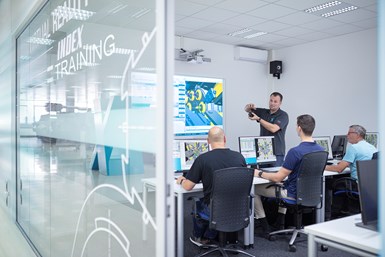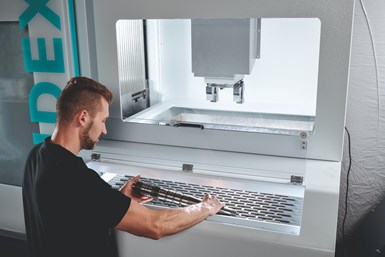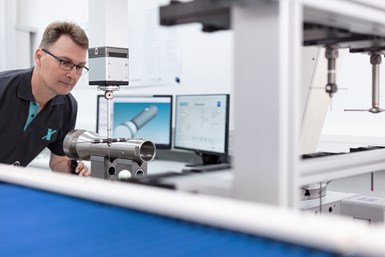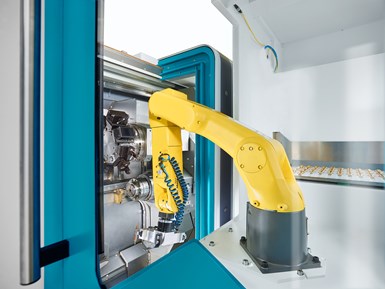Buy a Solution, Not a Machine
INDEX collaborates with customers to find a total solution to meet their needs.
By now, manufacturers are used to change. Since the turn of the century, the steady pace of technological advancement has made change the norm and the ability to adapt to it is a prerequisite for success. But even by those standards, the current moment is a lot to process.
The effects of 2020 continue to reverberate through the industry in ways both positive and negative. Early retirements created a knowledge drain of unforeseeable proportions, while the great resignation saw significant numbers of people transition both in and out of the industry midcareer.

Once a turnkey solution is developed, it is crucial to have effective knowledge transfer from the machine tool builder to the end user, including ongoing training of employees.
Supply chain disruptions hammered home the necessity of reshoring, resulting in substantial, ongoing government investment in the future of manufacturing.
And as Gen Z has entered the workforce, many companies have found it much harder to compete for top talent. Other industries are frequently better positioned to offer the level of flexibility that is so highly valued by many of the youngest working generation.
As companies have worked to meet new challenges while capitalizing on emerging opportunities, many have discovered the need to radically rethink fundamental aspects of how they do business. One dominant reevaluation has emerged in how shops view and select machine tool builders.
Technology Alone is Not a Solution
For many large and mid-size manufacturers, there has been a longstanding tendency to procure new machines primarily based on the combination of internal needs, equipment capabilities and price. Process development was typically considered an internal function that influenced, yet was generally separate from, the purchasing decision.
Today, labor is stretched thin and the higher the skill level required for a task, the further it tends to be stretched. Companies are frequently undertaking multiple initiatives to overcome this challenge.
Simplification of operation offers one way to counter the highly competitive market for skilled labor. While production cells have become a fixture in many facilities, there is now an increased focus on fully producing finished parts on a single machine with a single setup. Implemented properly, this can dramatically reduce the level of knowledge needed by operators, as well as allow them to service a greater number of machines.

Manufacturers can boost productivity and profitability by investing in a total solution that provides finished parts in a single setup.
Yet this approach demands not just highly capable and reliable equipment, but also bulletproof processes that can consistently produce high-quality parts. Creation of such processes requires a highly specialized knowledge of the specific machine tool being used, to a degree that is often beyond the scope of even veteran programmers.
This has rapidly caused a paradigm shift in the relationship between shop and machine tool builder, as the former relies on the latter not just for technology, but for the applications engineering expertise needed to use it effectively. Depending on factors such as part complexity, lot size and tolerance requirements, anywhere from very few to a relatively large percentage of builders can provide a shop with the technology it needs. A far smaller group is equipped to provide total solutions that include process development and implementation.
When Technology Isn’t Enough
To illustrate the difference between a provider of technology and a provider of solutions, consider the recent experience of a Midwestern manufacturer of aerospace engine components.
When calling on this company regarding a potential machine purchase, an Index salesperson noticed a relatively new machining cell centered around a turn mill, or multi-tasking machine, from a prominent brand. Given that the company was moving in the direction of producing parts fully on a single machine, the Index representative inquired if the cell had been purchased prior to a change in strategy. It had not.

An operator checks the status of a turnkey solution built around an INDEX G200 CNC turn mill.
Prior to purchasing the turn mill, the manufacturer was told that it would be able to perform all the necessary processes, which included gun drilling, gear hobbing and grinding. The builder even went so far as to provide a sample that included features similar to the manufacturer’s own part, with the assurance it had been produced on the machine model under consideration.
Unfortunately, once the machine was installed, new hurdles emerged. Performing the needed gun drilling required custom code and application of specialized tooling. The manufacturer lacked the capability to develop and implement these. The only engineers at the builder who might be able to assist were located in other countries, with schedules booked out months in advance. Similarly, the gear hobbing and grinding required the use of specific programming cycles that would require the assistance of overseas personnel to implement.
Faced with a level of delay that could possibly cost them work, the manufacturer quickly purchased a gun drilling center, gear grinder and robot to create a cell capable of production. It was not the solution they had hoped for in terms of floorspace, labor requirements or cost, but it was the only way to avoid losing work.
Identifying a Solutions Provider
For manufacturers looking to partner with a machine tool builder that provides total solutions as opposed to just technology, here are five key tips to help guide the selection process.
-
Make them prove their claims
In today’s world, you shouldn’t have to shoulder the risk of a machine not being able to live up to its builder’s claims. Stipulate that you will only accept delivery once you’ve seen the machine run your part within the specified parameters.

When purchasing a machine for a specific part or family of parts, a shop should ask the builder to prove that the machine can meet the necessary requirements.
-
Understand their applications capabilities
It’s absolutely vital to know the details of a builder’s team of applications engineers. Are they located in the US or another country? What’s the size of their team? How much experience and knowledge do they possess on the machine you’re considering? Understand their capabilities thoroughly.
-
Look for machine specialists, not generalists
As a follow-up to #1, ask about whether the builder’s engineers tend to have deep or broad knowledge of the machines they support. You will get very different results from a company with engineers responsible for supporting a wide variety of machine types and models vs a company with specialists with a near encyclopedic understanding of a smaller number of machines.
-
Ask about the install-to-engineer ratio
Some successful builders sell and install thousands of machines in a year, while others move less than a hundred. Both types can be excellent solutions providers, but your experience may largely depend on if they maintain an appropriately sized team for the number of machines they sell. This piece of data can help illustrate a key aspect of how much support you’ll receive from different builders.
-
Request customer references
Any builder with a history of meeting manufacturers’ needs should have some customers willing to talk about their own experience. Request to talk to one that has asked for a level of support similar to what you’re seeking, and be prepared to ask about the development and implementation process, how knowledge was transferred to their team and if the results they’ve achieved have lived up to what was promised.
What a True Solution Looks Like
At Index, we pride ourselves on the investment we’ve made in being able to provide customers with fully realized, comprehensive solutions. To offer one specific example of how this investment has benefited our customers, we can turn to a midwestern facility of a global leader that produces large equipment.
We were initially approached by this manufacturer when it was seeking to redefine its production for many of the reasons previously mentioned. A competitive labor market was making it hard to secure the skilled operators needed to grow. Floorspace was at a premium. Internal process development was strained beyond capacity.
As an initial job, the company asked us to replace a robotic cell containing a turn mill, 5-axis mill, grinder and finish reamer. Our proposals team met with their internal experts to evaluate and understand the part family, discuss priorities and determine the machine best suited to their needs.

A turnkey solution should include any automation or other technology needed to produce a finished part.
From there, our applications team went to work on developing a turnkey process solution built on our G220 turn mill center. The customer requested that we address every aspect of production, from tool selection to chip management to programming to part unloading. Once our team had a solution that fully met all of their criteria, we brought them to our facility to view the process in action and sign off on the purchase.
The project continued with machine installation, followed by training to facilitate knowledge transfer from our experts to theirs. Today, they have four G Series machines on their floor, two more in applications development and three additional on order. When all nine of these are installed, they will have replaced cells containing nearly thirty machines.
If you find yourself in a similar situation, knowing that you need to change, but lacking the internal resources to bring it to fruition, Index would love to discuss your future growth. And whether you select Index or another machine tool builder, know that there are options for solutions that far exceed a simple expansion of your existing processes.
